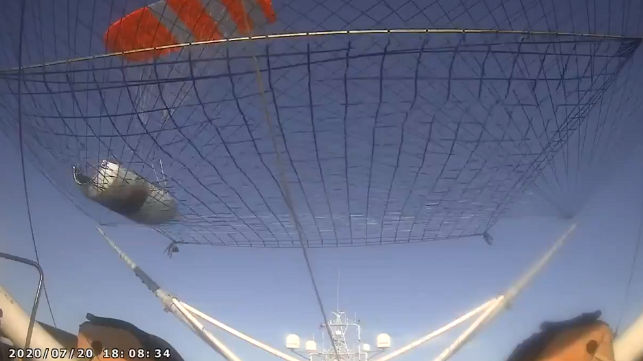Video: In First, SpaceX Recovers All Reusable Rocket Components at Sea

Space flight company SpaceX has been working for years on a ship-based system to catch and recover used rocket nose fairings without letting them go into the water. On Monday, it succeeded in catching both halves of a rocket fairing, along with the booster, in a set of maneuvers off the coast of Florida.
SpaceX has built its highly successful business by reusing rocket components wherever possible after each launch. After a SpaceX Falcon 9 booster delivers a satellite safely to orbit, it lands at a pad onshore or on a DP-equipped flat deck barge ("drone ship") at sea, depending on its trajectory. This is an industry first, and every reused booster rocket saves millions in manufacturing costs.
Each two-piece fairing costs $6 million, about 10 percent of the list price of a Falcon 9 launch, so recovering even one half could generate significant savings. However, there is a technical problem: the fairings fall back to earth over the open ocean, and if they land in the water, SpaceX will not reuse them due to concerns over corrosion. (Satellite payloads are worth hundreds of millions of dollars - far more than the rocket, let alone one fairing.)
Instead, SpaceX has chartered a handful of offshore crew boats and built the equivalent of a giant catchers' mitt on the back of each. This device has the form of a net supported by four long arms stretched far out over the side. As the fairing returns through the atmosphere, a small parachute slows its descent, and the crewboat transits to rendezvous with it. If all goes well, the fairing lands in the net.
After a military satellite launch Monday - the 90th launch of a Falcon 9 booster - that plan succeeded fully for the first time, and both fairings fell into the net as intended.
Videos of yesterday’s catch of both fairing halves pic.twitter.com/yzTDFzlulL
— SpaceX (@SpaceX) July 21, 2020
In an operation that has become somewhat routine, the booster also landed successfully aboard the drone ship Just Read the Instructions, the 57th time that SpaceX has landed a booster at sea.
 Stay on Top of the Daily Maritime News The maritime news
Stay on Top of the Daily Maritime News The maritime news
that matters mostGet the latest maritime news delivered to your inbox daily.
Falcon 9’s first stage has landed on the Just Read the Instructions droneship pic.twitter.com/fPbckYFySh
— SpaceX (@SpaceX) July 20, 2020
The launch was remarkable for other reasons. The booster delivered its payload - the South Korean military satellite Anasis II - without issue, just 51 days after its previous launch. It is the fastest turnaround time ever recorded for the second launch of a reused rocket.
